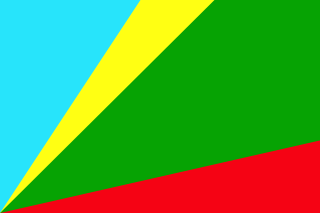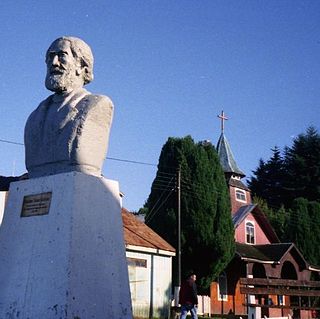Related Research Articles

The Huilliche, Huiliche or Huilliche-Mapuche are the southern partiality of the Mapuche macroethnic group in Chile and Argentina. Located in the Zona Sur, they inhabit both Futahuillimapu and, as the Cunco or Veliche subgroup, the northern half of Chiloé Island. The Huilliche are the principal indigenous people of those regions. According to Ricardo E. Latcham the term Huilliche started to be used in Spanish after the second founding of Valdivia in 1645, adopting the usage of the Mapuches of Araucanía for the southern Mapuche tribes. Huilliche means 'southerners' A genetic study showed significant affinities between Huilliches and indigenous peoples east of the Andes, which suggests but does not prove a partial origin in present-day Argentina.

Los Lagos Region is one of Chile's 16 regions, which are first order administrative divisions, and comprises four provinces: Chiloé, Llanquihue, Osorno and Palena. The region contains the country's second largest island, Chiloé, and the second largest lake, Llanquihue. Its capital is Puerto Montt; other important cities include Osorno, Castro, Ancud, and Puerto Varas. The mainland portion of Los Lagos Region south of Reloncaví Sound is considered part of Patagonia.

Puerto Montt is a port city and commune in southern Chile, located at the northern end of the Reloncaví Sound in the Llanquihue Province, Los Lagos Region, 1,055 km to the south of the capital, Santiago. The commune spans an area of 1,673 km2 (646 sq mi) and has a population of 245,902 in 2017. It is bounded by the communes of Puerto Varas to the north, Cochamó to the east and southeast, Calbuco to the southwest and Maullín and Los Muermos to the west.

Frutillar is a city and commune located in southern Chile, Chilean Patagonia, in Llanquihue Province, within the Los Lagos Region, the lake district. The bay of Frutillar is placed on the banks of Lake Llanquihue, the largest lake entirely within Chile. Frutillar is known as the "City of Music", and since 2017 is part of the UNESCO Creative Cities Network (UCCN), becoming the first Chilean city to be nominated, as well as the southernmost Creative City of Music in the world.

Llanquihue Province is one of four provinces of the Chilean region of Los Lagos (X). Its capital is Puerto Montt. Chile's second largest lake, Lake Llanquihue, is located in the province as well as four volcanoes: Osorno, Calbuco, Puntiagudo and Cerro Tronador.

Puerto Varas, also known as "La ciudad de las rosas" or “the city of roses”, is a city and commune located in the southern Chilean province of Llanquihue, in the Los Lagos Region.

Calbuco is a stratovolcano in southern Chile, located southeast of Llanquihue Lake and northwest of Chapo Lake, in the Los Lagos Region, and close to the cities of Puerto Varas and Puerto Montt. With an elevation of 2,015 meters above sea level, the volcano and the surrounding area are protected within the Llanquihue National Reserve.

The Chiloé Archipelago is a group of islands lying off the coast of Chile, in the Los Lagos Region. It is separated from mainland Chile by the Chacao Channel in the north, the Sea of Chiloé in the east and the Gulf of Corcovado in the southeast. All islands except the Desertores Islands form Chiloé Province. The main island is Chiloé Island. Of roughly rectangular shape, the southwestern half of this island is a wilderness of contiguous forests, wetlands and, in some places, mountains. The landscape of the northeastern sectors of Chiloé Island and the islands to the east is dominated by rolling hills, with a mosaic of pastures, forests and cultivated fields.
Chonchi is a Chilean town and commune located in Los Lagos Region. The commune consists of the town of Chonchi and the following villages:

Quemchi is a Chilean town and commune in Los Lagos Region, in Chiloé Province, on the eastern shore of Chiloé Island. It acquired reputation because the famous Chilean writer Francisco Coloane was born near the town.

Cochamó is a Chilean town and commune located in Llanquihue Province, Los Lagos Region. The capital of the commune is the town of Río Puelo, which is named after the Puelo River.

Calbuco is a city and commune in southern Chile administered by the Municipality of Calbuco. Administratively Calbuco belongs to the Llanquihue Province of Los Lagos Region. The origin of the city was the Spanish Fort Calbuco founded in 1603, and became later an important fish market. The archaeological site of Monte Verde lies within the commune.

Maullín is Chilean town and commune in Llanquihue Province which is part of Los Lagos Region. The commune is located in at the outflow of Maullín River.

Llanquihue is a Chilean commune and city in Llanquihue Province, Los Lagos Region. The city lies on the western shore of Lake Llanquihue, where the Maullín River starts. It is located 7 kilometres (4.3 mi) north of Puerto Varas and 19 kilometres (12 mi) south of Frutillar and is connected to both cities by Chile Highway 5.
Calbuco is a city and commune in Llanquihue Province, Chile.

Calbuco Archipelago is located in the Reloncaví Sound, Llanquihue Province, Los Lagos Region, Chile.

Abtao Island is part of the Chiloé Archipelago, Chile.
Caucahué is an island located in the Caucahué Channel, Chiloé Province, Los Lagos Region, Commune of Quemchi in southern Chile. It has a population of 354 according to the 2017 census, this is almost a halving relative to the 638 inhabitants recorded in the 2001 Chilean census. The island supplies the city of Quemchi with farm and sea products.

The last glacial period and its associated glaciation is known in southern Chile as the Llanquihue glaciation. Its type area lies west of Llanquihue Lake where various drifts or end moraine systems belonging to the last glacial period have been identified. The glaciation is the last episode of existence of the Patagonian Ice Sheet. Around Nahuel Huapi Lake the equivalent glaciation is known as the Nahuel Huapi Drift.

The red tide crisis in Chiloé, also known as "Chilote May", was a social, economic and environmental catastrophe that occurred in the Chiloé Archipelago, southern Chile, in the southern autumn of 2016, as a result of a severe algal bloom of the dinoflagellate Alexandrium catenella — a microalgae responsible for the phenomenon known as red tide. The bloom spanned the months of March and April and affected the outer sea of the Los Lagos Region, the inland coast of Chiloé, and the Chacao Channel. It affected thousands of artisanal fishermen on the Chiloé Island —in addition to other communes such as Calbuco, Maullín and Puerto Montt because they prohibited from extracting marine resources due to widsepread contamination with paralytic shellfish poison (PSP).
References
- ↑ (in Spanish) Calbuco
- ↑ (in Spanish) La Población de Calbuco Archived 2011-05-29 at the Wayback Machine